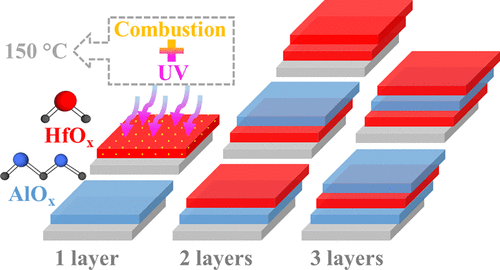
E. Carlos et al., ACS Appl. Mater. Interfaces, 9 (46), 40428–40437, 2017
Abstract
In the past decade, solution-based dielectric oxides have been widely studied in electronic applications enabling the use of low-cost processing technologies and device improvement. The most promising are the high-κ dielectrics, like aluminum (AlOx) and hafnium oxide (HfOx), that allow an easier trap filling in the semiconductor and the use of low operation voltage. However, in the case of HfOx, a high temperature usually is needed to induce a uniform and condensed film, which limits its applications in flexible electronics. This paper describes how to obtain HfOxdielectric thin films and the effect of their implementation in multilayer dielectrics (MLD) at low temperatures (150 °C) to apply in thin film transistors (TFTs) using the combination of solution combustion synthesis (SCS) and ultraviolet (UV) treatment. The single layers and multilayers did not show any trace of residual organics and exhibited a small surface roughness (<1.2 nm) and a high breakdown voltage (>2.7 MV·cm–1). The resulting TFTs presented a high performance at a low operation voltage (<3 V), with high saturation mobility (43.9 ± 1.1 cm2·V–1·s–1), a small subthreshold slope (0.066 ± 0.010 V·dec–1), current ratio of 1 × 106 and a good idle shelf life stability after 2 months. To our knowledge, the results achieved surpass the actual state-of-the-art. Finally, we demonstrated a low-voltage diode-connected inverter using MLD/IGZO TFTs working with a maximum gain of 1 at 2 V.